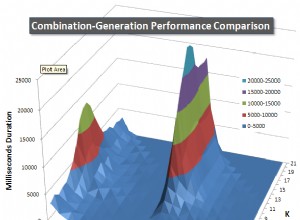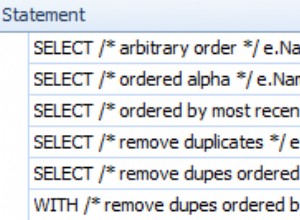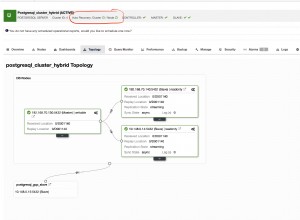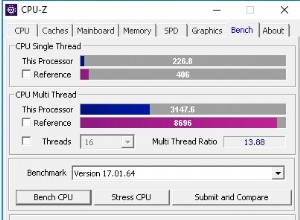Jika CSV tidak terlalu besar dan tersedia di komputer lokal Anda, maka csvkit adalah solusi paling sederhana. Ini juga berisi sejumlah utilitas lain untuk bekerja dengan CSV, jadi ini adalah alat yang berguna untuk mengetahui secara umum.
Paling sederhana mengetik ke dalam shell:
$ csvsql myfile.csv
akan mencetak CREATE TABLE yang diperlukan Perintah SQL, yang dapat disimpan ke file menggunakan pengalihan output.
Jika Anda juga menyediakan string koneksi csvsql akan membuat tabel dan mengunggah file sekaligus:
$ csvsql --db "$MY_DB_URI" --insert myfile.csv
Ada juga opsi untuk menentukan ragam SQL dan CSV yang sedang Anda kerjakan. Mereka didokumentasikan dalam bantuan bawaan:
$ csvsql -h
usage: csvsql [-h] [-d DELIMITER] [-t] [-q QUOTECHAR] [-u {0,1,2,3}] [-b]
[-p ESCAPECHAR] [-z MAXFIELDSIZE] [-e ENCODING] [-S] [-H] [-v]
[--zero] [-y SNIFFLIMIT]
[-i {access,sybase,sqlite,informix,firebird,mysql,oracle,maxdb,postgresql,mssql}]
[--db CONNECTION_STRING] [--query QUERY] [--insert]
[--tables TABLE_NAMES] [--no-constraints] [--no-create]
[--blanks] [--no-inference] [--db-schema DB_SCHEMA]
[FILE [FILE ...]]
Generate SQL statements for one or more CSV files, create execute those
statements directly on a database, and execute one or more SQL queries.
positional arguments:
FILE The CSV file(s) to operate on. If omitted, will accept
input on STDIN.
optional arguments:
-h, --help show this help message and exit
-d DELIMITER, --delimiter DELIMITER
Delimiting character of the input CSV file.
-t, --tabs Specifies that the input CSV file is delimited with
tabs. Overrides "-d".
-q QUOTECHAR, --quotechar QUOTECHAR
Character used to quote strings in the input CSV file.
-u {0,1,2,3}, --quoting {0,1,2,3}
Quoting style used in the input CSV file. 0 = Quote
Minimal, 1 = Quote All, 2 = Quote Non-numeric, 3 =
Quote None.
-b, --doublequote Whether or not double quotes are doubled in the input
CSV file.
-p ESCAPECHAR, --escapechar ESCAPECHAR
Character used to escape the delimiter if --quoting 3
("Quote None") is specified and to escape the
QUOTECHAR if --doublequote is not specified.
-z MAXFIELDSIZE, --maxfieldsize MAXFIELDSIZE
Maximum length of a single field in the input CSV
file.
-e ENCODING, --encoding ENCODING
Specify the encoding the input CSV file.
-S, --skipinitialspace
Ignore whitespace immediately following the delimiter.
-H, --no-header-row Specifies that the input CSV file has no header row.
Will create default headers.
-v, --verbose Print detailed tracebacks when errors occur.
--zero When interpreting or displaying column numbers, use
zero-based numbering instead of the default 1-based
numbering.
-y SNIFFLIMIT, --snifflimit SNIFFLIMIT
Limit CSV dialect sniffing to the specified number of
bytes. Specify "0" to disable sniffing entirely.
-i {access,sybase,sqlite,informix,firebird,mysql,oracle,maxdb,postgresql,mssql}, --dialect {access,sybase,sqlite,informix,firebird,mysql,oracle,maxdb,postgresql,mssql}
Dialect of SQL to generate. Only valid when --db is
not specified.
--db CONNECTION_STRING
If present, a sqlalchemy connection string to use to
directly execute generated SQL on a database.
--query QUERY Execute one or more SQL queries delimited by ";" and
output the result of the last query as CSV.
--insert In addition to creating the table, also insert the
data into the table. Only valid when --db is
specified.
--tables TABLE_NAMES Specify one or more names for the tables to be
created. If omitted, the filename (minus extension) or
"stdin" will be used.
--no-constraints Generate a schema without length limits or null
checks. Useful when sampling big tables.
--no-create Skip creating a table. Only valid when --insert is
specified.
--blanks Do not coerce empty strings to NULL values.
--no-inference Disable type inference when parsing the input.
--db-schema DB_SCHEMA
Optional name of database schema to create table(s)
in.
Beberapa alat lain juga melakukan inferensi skema termasuk:
- Apache Spark
- Panda (Python)
- Blaze (Python)
- read.csv + paket db favorit Anda di R
Masing-masing memiliki fungsionalitas untuk membaca CSV (dan format lain) ke dalam struktur data tabular yang biasanya disebut DataFrame atau yang serupa, menyimpulkan jenis kolom dalam proses. Mereka kemudian memiliki perintah lain untuk menulis skema SQL yang setara atau mengunggah DataFrame langsung ke database tertentu. Pilihan alat akan bergantung pada volume data, cara penyimpanannya, keistimewaan CSV Anda, basis data target, dan bahasa yang Anda pilih untuk digunakan.




